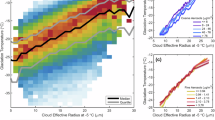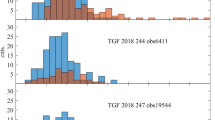Abstract
DURING the GT-5 manned spacecraft flight mission of August 21–29, 1965, an experiment to determine the cloud top altitude was performed. The instrument used in this experiment has been described by Saiedy et al.1. It is a compact grating spectrograph-camera which records simultaneously a photograph of the cloud and its spectrum from 7500 Å to 7800 Å. Fig. 1 shows a reproduction of one of the 26 observations obtained during the mission. This photograph-spectrogram was taken over a cloudy area in the inter-tropical convergence zone (ITC) at 12° 37′ N., 99° 10′ W., at 1944:02 G.C.T., August 25.
This is a preview of subscription content, access via your institution
Access options
Subscribe to this journal
Receive 51 print issues and online access
$199.00 per year
only $3.90 per issue
Buy this article
- Purchase on SpringerLink
- Instant access to full article PDF
Prices may be subject to local taxes which are calculated during checkout
Similar content being viewed by others
References
Saiedy, F., Hilleary, D. T., and Morgan, W. A., App. Optics, 4, 495 (1965).
Wark, D. Q., and Mercer, D. M., App. Optics, 4, 839 (1965).
Author information
Authors and Affiliations
Rights and permissions
About this article
Cite this article
SAIEDY, F., MORGAN, W. & WARK, D. Determination of Cloud Altitudes from Gemini-Titan-5. Nature 208, 775 (1965). https://doi.org/10.1038/208775a0
Issue date:
DOI: https://doi.org/10.1038/208775a0



